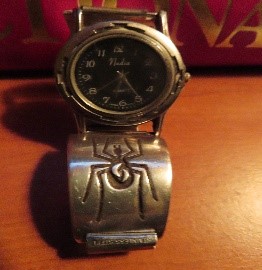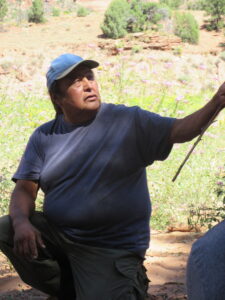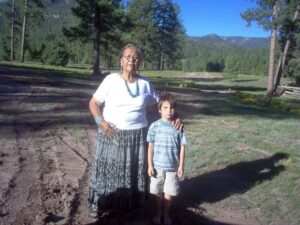“Once you’ve walked and left footprints in the canyon a part of you will always be here,” Daniel said. What he didn’t say was that Canyon de Chelly, Arizona will call you back. And so, it has for over 30 years.Every return has been different yet somehow always the same. On one occasion I was joined by 13 others. Some had been to the Canyon before, some never. But all had heard the call. It was October, 6 a.m. and dark in Santa Fe when we started the journey, none of us including me sure of what lay ahead but truly ready to go on the adventure.
First, we offered cornmeal to feed the directions, the morning, our journey, the vehicles and each other and all others. It was an Indigenous tradition from the Southwest I had been shown to do, and almost every early dawn whether it was downtown Washington, D.C., Kolkata, India or my own backyard in Santa Fe, I had done so. Dinè (Navajo) elder Annie Kahn, in the spirit world as of this writing, once led me in dawn prayer, when the stars were shining and a thin line of light threaded its way across the eastern horizon. She said it was a special time of “Hòzòn” (beauty in the Dinè language) when prayers could be sent and heard most clearly. Annie was and is still a light in the dark for me and many others.
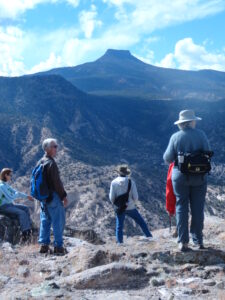 Offerings made, we traveled on past pine clad mountains, the looming flat-topped volcanic Tsi Ping (Pedernal) peak made famous by artist Georgia O’Keeffe, through red sandstone cliffs of Gallina, the rolling plains near Regina, past billboards, gas stations and fast food eateries of Bloomfield and Farmington.
Offerings made, we traveled on past pine clad mountains, the looming flat-topped volcanic Tsi Ping (Pedernal) peak made famous by artist Georgia O’Keeffe, through red sandstone cliffs of Gallina, the rolling plains near Regina, past billboards, gas stations and fast food eateries of Bloomfield and Farmington.
We stopped as if compelled by some invisible force near the visually stunning and dramatic immensity of a sharply jagged dark peak commonly known as Shiprock. No ships around here, though. It was a misnomer. The Dinè named the peak Tse Bit’a’i, “rock with wings” which refers to the legend of a great bird that brought the Dinè from the north to their present lands. Other traditional stories surround this mountain which thrusts starkly upwards into the cobalt blue sky with its “wings” of volcanic rock radiating north and south from the central formation.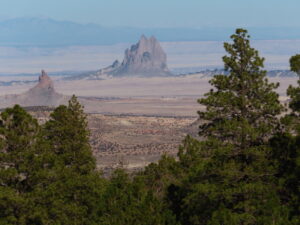
Traveling westward we snaked our way over the Lukachukai Mountains, with stunning views towards Tse Bit’ a’ i’ in the east, then dropped down through massive red sandstone cliffs to the west, eventually reaching the mouth of Canyon de Chelly and the Dinè family who would be our guides for four days.
From the Earth Walks I remember:
- At the beginning of our descent down the long and winding trail from the canyon rim, Roshi Richard Baker’s answer to Joan Halifax in her Zen training: She asked, “Roshi, there is the path and there is the temple at the end of the path. What is the meaning of the path?” His response: “Joan, the path IS the temple.” Step by step, some labored, we threaded our way down, then reached our new home for three days in the canyon. We left our footprints in the sand, soul signatures that would call some of us back here again.
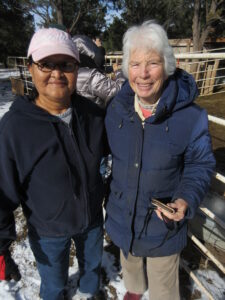 Guide Daniel Staley’s cousin Esther Bia who accompanied us shared, “My mother said to always leave a little food on your plate for the ‘hungry spirit.’ In times of need you will be helped.”
Guide Daniel Staley’s cousin Esther Bia who accompanied us shared, “My mother said to always leave a little food on your plate for the ‘hungry spirit.’ In times of need you will be helped.” - At dawn, Daniel’s flute and prayer chants echoed against the dark cliffs against a sea of infinite stars, meteors streaking across the horizon. Daniel told us on the trail down: “Whenever you need, face the canyon wall and let everything go that needs to go. It will help change you.”
- I woke up in the tent the first morning with persistent joint pains gone! Where did they go? Someone said, “To Mother Earth!” I felt joy and energy enough to run the canyon.
- We did service work at a canyon resident’s land, digging the fence line free of sand blown over by fierce winds; clearing the fields of dead and down wood and hauling heavy sheet rock from a truck to the house.
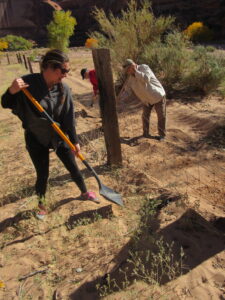
- Then we visited the home of another resident in the canyon. It was an amazing contrast of nearby ancient cliff dwellings in the canyon wall and a set of active solar panels generating electricity for the house. Even though it was a bright sunny afternoon, she and her grandson lit a fire outdoors, a traditional welcome to visitors. We shared lunch and her family stories.
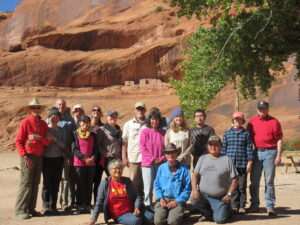
- During 35 mile and hour swirling gusts of wind we shook ourselves out of old habits and thoughts through a sweat lodge. It is as if the winds carried away our prayers to where they needed to go. When we were out of the lodge the winds calmed. As we began the ceremony, a hawk flew to a perch atop the canyon wall, overlooking our doings. I thought: this is the spirit of Daniel’s grandparents, on whose land sat. His family was here and we had become part of the family as well.
- When we first arrived at the campsite, Esther urged us to build a fire as soon as possible, to let everyone—seen and unseen—know we were there. I took it to be a kind of welcoming as well as a friendly protection. As a member of the Scottish McKenzie Fire Klan on my mother’s side of the family, I liked that idea. After all, I lit candles in my parents’ basement when I was six years old and stared into the flame, fascinated with the small fire but I think truly I was seeking the fire of spirit. Jesuit philosopher Pierre Teilhard de Chardin once said, “The day will come when, after harnessing space, the winds, the tides and gravitation, we shall harness for God the energies of love. And on that day, for the second time in the history of the world, we shall have discovered fire.” Perhaps on that Earth Walks we rediscovered those energies as well.
The important thing is not to stop questioning. Curiosity has its own reason for existing. One cannot help but be in awe when on contemplates the mysteries of eternity, of life, of the marvelous structure of reality. It is enough if one tries merely to comprehend a little of this mystery every day.
—Albert Einstein

